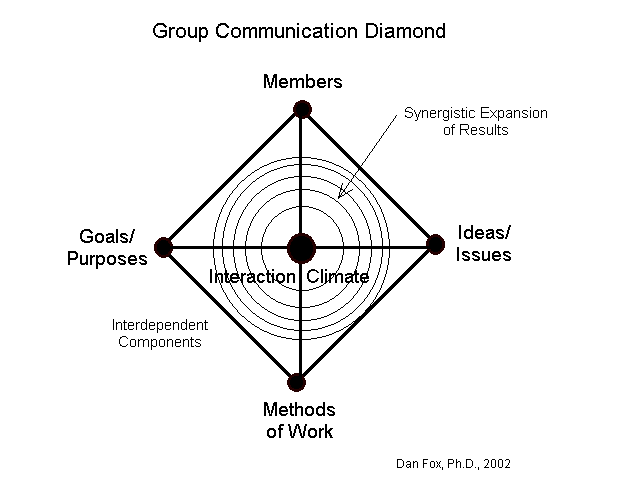Models and Theory of Communication
Models and Theory of Group Communication
This page will preview some of the central models and theory of communication, especially as it applies to group dynamics.
Tuckman's Stages and Fisher's Phases
Tuckman's Stages:
1. Forming
2. Storming
3. Norming
4. Performing
5. Adjourning (added later by another theorist)
Fisher's Phases:
1. Orientation
2. Conflict
3. Emergence
4. Reinforcement
Links to other useful sites:
Communication Theory webpage:
There is a webpage devoted to communication theory; the link is available on the speech communication main page under links. (It is Http://www.communication-theory.freeservers.com.)
Speech Prof webpage:
This is the main site and contains links to other courses.

Group Communication Diamond
This model is synthesized and reframed from basic group communication research. Members are those participating in the group. Ideas and issues include the content of their communication and group work. Methods of work are the procedures for getting work done, ways of making decisions, and how to approach their common task or problem. Goals and purposes are similar, although groups usually share a vision of what should be done based on their common purpose, whereas the goals are often smaller, more achievable steps toward achieving their purpose. Purpose might be thought of as an extension of their vision, whereas goals are the steps they have developed toward the realization of their vision. At the center, surrounded by the fundamental components of members, ideas/issues, methods of work, and goals/purposes, is climate. Climate is a metaphor for the relational ease or dis-ease felt by the participants. We sometimes call the climate the "spirit" of interaction, the "atmosphere," "tone" of relationships, vibe, or sense of comfort within the group. This climate, alone, can make or break the group's effectiveness and future purposes. Destructive, downward conflict spirals can destroy the climate, while constructive and people-building spirals can elevate the group into a new sense of energy, purpose, and direction.
All of these parts are interdependent. Each impact the others to some degree.
When all are functioning effectively, a synergistic expansion of their input can occur, resulting in exponential results. Synergy, again, is our idea that the end result is greater than a sum of the individual parts. Here is where we explain the great teams, the excellent performances of groups, the peak performers of arts, sports, academics, and the workplace. The individual group members are contributing positively and consistently, each seeking to develop a positive group climate, encouraging other members to work toward their common goals and purposes.
Basic Communication Model
We will examine the components of this model during the first two weeks of the course. Understanding this model is at the root of our future discussion of communication in groups. We teach a transactional view of human communication, and this dynamic, symultaneous process of sharing and understanding meaning impacts much of what we see in group dynamics.
Conflict Styles and Group Performance
1. Avoidance: the "Turtle"
2. Accomodation: the "Teddy Bear"
3. Competition: the "Shark"
4. Collaboration: the "Owl"
5. Compromise: the "Fox"